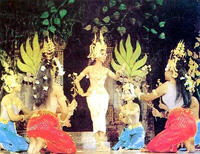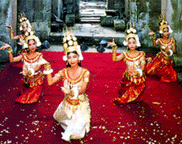|
The High Speed Internet is easy to watch!
The fine-boned young princess, clad in silk and glittering jewels, performed beneath the stars on the open pavilion within the palace walls, accompanied by the Royal Dance Troupe and the "pinpeat" orchestra: gongs,drums. xylophones, horns and stringed instruments. Selected by her grandmother. Queen Sisowath Monivong Kossomak Neary Rath Serey Vattana. to become a dancer when she was only a baby, she toured the world as the "white Apsara" or principal dance of the classical Cambodian ballet-a stunningly graceful, 2,000-year-old blend of sinuous hand gestures and sensuous body movements, all deep with meaning.
Responsible for its rebirth, she became the symbol of classical Khmer dancing, dormant since the 15th century, when the glory of Angkor faded and with it Khmer cultural dominance of Southeast Asia.
In reviving the classical dance, Queen Kossomak and Preincess Buppha Devi brought the dance not only to the world but-for the first time-the Cambodian people. In the past, the classical dance was the Royal dance, performed only before royalty to commemorate their dynastic ancestors and to honor the gods.
 It is one of two major forms of Khmer dancing, and incorporates parts of the other, much-older traditional or popular dancing, which has its roots in animism and primitive magic, with Hindu forms introduced during the time of Indian influence beginning in the 1st century. It is one of two major forms of Khmer dancing, and incorporates parts of the other, much-older traditional or popular dancing, which has its roots in animism and primitive magic, with Hindu forms introduced during the time of Indian influence beginning in the 1st century.
Classical dance took on its own unique form, adding movements and meaning, during the reigns of Kings Jayavarman II to VII. By the 13th century, it was more Khmer than Indian, unlike any other dance form in the world. At the heart of classical form is the Apsara, the joyful, almost wanton dancer whose images are everywhere. Princess Buppha Devi, who currently serves as the Minister of Culture, is a master of Apsar dancing, which dates to the 1st century. The graceful movements of the Apsara dancers, adorned with gold headdresses and silken tunics and skirts, are carved on the walls of many of the temples at Angkor. Estimates are that there were 3,000 Apsara dancers in the 12th century court of King Jayavarman VII. Over the centuries Khmer dancing lent its influence to the classical ballet of neighboring countries, and some of its postures and movements are similar to other Southeast Asian dance forms. But according to Princess Buppha Devi, "The Khmer kingdom started its traditions in the 8th century, 500 years before Thailand." In 1400, with the sacking of the Angkor Empire, the Apsara dancers were seized and taken to Thailand. Apsara dancing is one of two elements of classical ballet, the other being "today" dancing, the depiction of early myths. Many of the dances involve performing a fragment of the Ramayana, the ancient Indian epic that is one and a half times as long as the Odyssey. Others are based on the legendary battles and mythical sagas carved in bas relief on the walls of the temples of Angkor-including the Churning of the Sea of Milk, the great battle between gods and demons for the holy liquid that gives immortality. There are 100 dances and dramas. There are four typical roles of Khmer dance: male, female, giant and monkey, the first three being the domain of women and girls, leaving the monkey roles to the men. In the early days, it is believed that all dancers were female. Most of the dancers in the Royal Dance Troupe today are female. In December 1995, Cambodia revived its Ramayana tradition after 25 years with a performance of the epic at Angkor Wat. Dancers came from six countries as part of a Southeast Asia cultural exchange. The dances are full of meaning, with each gesture symbolizing something, from great concepts such as love and peace to small-a finger to the sky means "today." arms crossed over the chest "very happy," and the left arm stretched out behind the dancer, right hand held up before the chest with three fingers up and index finger touching the thumb depict the naga, the great many-headed snake that symbolizes the spirit of the Cambodian people. A hand up means "dead," one down "alive," and fast switching up and down depicts two of the four parts of human life in Buddhist teaching: birth, life, sickness and death. Besides the life of a human, forma kinds of apsara dancing also honor the naga and immortality. Princess Buppha Devi says that over the centuries the hand gestures have changed very little, although the organization of the royal troupe has changed often, with each reigning king. As she puts it, "The ballet belongs to the Kingdom and His Majesty the King is in charge."
Like much of classical dance, the hand gestures were born in the other major form of Khmer dancing, popular or traditional, This dates back to the earliest days, before Indian influence. and has roots in early animism, the worship of the spirits of trees, animals and other natural things. You readily can see traditional dancing at almost any social gathering, when Khmer people dance slowly in a circle, gesturing gracefully with their hands. Other kinds of traditional dancing are the peacock and wedding dances.
Traditional dancing never died out in Cambodia, unlike classical dance. Both forms thrive now. Queen Kossomak modernized many traditions, and she herself went to the primary schools to seek out girls with the bones and graceful limbs who would make good dancers. These young girls were trained initially at school outside the palace, and eventually trained inside the palace, a system that remains in place today.
 Nowadays, children selected for dance training are taught to do hand exercises at an early age to loosen their joints. Dancers must be trained while the bones are still supple. Apsara dancers' finger are extraordinarily elastic, they can bend their fingers backward almost to the wrist. Nowadays, children selected for dance training are taught to do hand exercises at an early age to loosen their joints. Dancers must be trained while the bones are still supple. Apsara dancers' finger are extraordinarily elastic, they can bend their fingers backward almost to the wrist.
One of the most prominent choreographers in Cambodia today is Proeung Chhieng, 47, a former member of the royal dance troupe who used to perform with Princess Buppha Devi. His grandmother was a member of the Royal Dance Troupe and he and his sister, also a royal dancer, used to follow her around the palace grounds while she trained. At age 8 he went into formal training under his grandmother. "I always played the monkey role because of its acrobatics," he said. The royal dancers weren't paid particularly well-his first salary was 25 Riel. or about 1 cent. At 17 he became a dance teacher. He is one of only a handful of dance teachers to have survived the Khmer Rouge regime that resulted in the deaths of most of the intellectuals and artists.
In addition to classical, traditional dancing also is taught at the Royal University of Fine Arts, along with masked drama, shadow puppets, classical Cambodian music and circus arts, Proeung Chhieng says. As in the old days, technical training is given in the morning and regular schooling takes place in the afternoon.
Although now retired from professional dancing, Princess Buppha Devi continues to dazzle audiences through her work as director of the 300 dancers who belong to the modern Royal Ballet.
Today, apsara dancing performances are no longer relegated to the gods and kings. Performances can been seen at the major hotels, and at Chatomuk Theater near the Royal Palace. With the tinkling of xylophones and a euphony of gongs and drums, the apsara dancers, dressed in their tightly fitted silk tunics embroidered in gold and silver, barefoot but with elaborate headdresses, and out-stretched arms symbolizing the naga and glistening with jewelry, enter the stage to perform with incredible grace,
 Dancing holds great significance for the Khmer people, and the government considers the Royal Ballet in particular to be a national treasure. Princess Buppha Devi, along with the Ministry of Culture, is helping to ensure that its traditions will flourish in the next century. As Proeung Chhieng firmly believes, "Dance is our national soul." Dancing holds great significance for the Khmer people, and the government considers the Royal Ballet in particular to be a national treasure. Princess Buppha Devi, along with the Ministry of Culture, is helping to ensure that its traditions will flourish in the next century. As Proeung Chhieng firmly believes, "Dance is our national soul."
|
